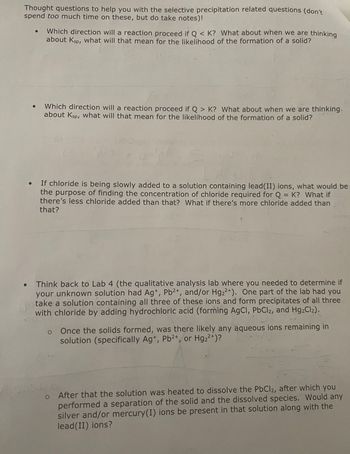
Chemistry
10th Edition
ISBN: 9781305957404
Author: Steven S. Zumdahl, Susan A. Zumdahl, Donald J. DeCoste
Publisher: Cengage Learning
expand_more
expand_more
format_list_bulleted
Question
I need help on these questions?

Transcribed Image Text:Thought questions to help you with the selective precipitation related questions (don't
spend too much time on these, but do take notes)!
Which direction will a reaction proceed if Q< K? What about when we are thinking
about Ksp, what will that mean for the likelihood of the formation of a solid?
Which direction will a reaction proceed if Q> K? What about when we are thinking.
about Ksp, what will that mean for the likelihood of the formation of a solid?
yle
If chloride is being slowly added to a solution containing lead(II) ions, what would be
the purpose of finding the concentration of chloride required for Q = K? What if
there's less chloride added than that? What if there's more chloride added than
that?
Think back to Lab 4 (the qualitative analysis lab where you needed to determine if
your unknown solution had Ag+, Pb2+, and/or Hg22+). One part of the lab had you
take a solution containing all three of these ions and form precipitates of all three
with chloride by adding hydrochloric acid (forming AgCl, PbCl2, and Hg₂Cl2).
o
Once the solids formed, was there likely any aqueous ions remaining in
solution (specifically Ag+, Pb²+, or Hg₂²+)?
2-
After that the solution was heated to dissolve the PbCl2, after which you
performed a separation of the solid and the dissolved species. Would any
silver and/or mercury(I) ions be present in that solution along with the
lead(II) ions?
Expert Solution
This question has been solved!
Explore an expertly crafted, step-by-step solution for a thorough understanding of key concepts.
This is a popular solution
Trending nowThis is a popular solution!
Step by stepSolved in 3 steps with 2 images

Knowledge Booster
Learn more about
Need a deep-dive on the concept behind this application? Look no further. Learn more about this topic, chemistry and related others by exploring similar questions and additional content below.Similar questions
- Can you please teach us how to think about this? See question number 10. This is not a graded question as it is a practice question . I am 60 years old and helping my son prepare for the AP exam in a few months. We do questions at the back of the textbook by Zumdahl and Zumdahlarrow_forwardWhat's 12,13 and 16?arrow_forwardIn the following sub-questions, use your book and notes to generate an argument for each model of light. Remember, on the first day of class we discussed that argumentation requires: ● a claim (which I've given), • evidence (which you should look up in the form of data or scientific principles) and reasoning that connects the evidence to the claim (which you should generate from your understanding so far).arrow_forward
- What is green chemistry? Choose the BEST answer. O Chemistry that uses only recycled chemicals. O Chemistry that makes something green in color. O Chemistry that comes from plants or uses plant materials. O Chemistry that uses non-toxic, non-harmful chemicals.arrow_forwardAssume the data below was collected for two different sample solutions using the same experimental procedure you carried out. Based on the two lines shown below, which solution (orange data points or blue data points) corresponds to the sample that would look DARKER in terms of how much light goes through the glass. 0.9 y= 4.7713x - 0.0728 R0.99953 0.8 0.7 0.6 0.5 0.4 0.3 0.2 y1.414x - 0.0546 R0.99642 0.1 0.02 0.04 0.06 0.08 0.1 0.12 0.14 0.16 0.18 0.2 0.1 [Concentration, M] orange data points (lower line) blue data points (upper line) Absorbancearrow_forwardWhat is -30°F in K? O 30K ЗОК O 303 K О-30 К 0239 К 04Karrow_forward
arrow_back_ios
arrow_forward_ios
Recommended textbooks for you
 ChemistryChemistryISBN:9781305957404Author:Steven S. Zumdahl, Susan A. Zumdahl, Donald J. DeCostePublisher:Cengage Learning
ChemistryChemistryISBN:9781305957404Author:Steven S. Zumdahl, Susan A. Zumdahl, Donald J. DeCostePublisher:Cengage Learning ChemistryChemistryISBN:9781259911156Author:Raymond Chang Dr., Jason Overby ProfessorPublisher:McGraw-Hill Education
ChemistryChemistryISBN:9781259911156Author:Raymond Chang Dr., Jason Overby ProfessorPublisher:McGraw-Hill Education Principles of Instrumental AnalysisChemistryISBN:9781305577213Author:Douglas A. Skoog, F. James Holler, Stanley R. CrouchPublisher:Cengage Learning
Principles of Instrumental AnalysisChemistryISBN:9781305577213Author:Douglas A. Skoog, F. James Holler, Stanley R. CrouchPublisher:Cengage Learning Organic ChemistryChemistryISBN:9780078021558Author:Janice Gorzynski Smith Dr.Publisher:McGraw-Hill Education
Organic ChemistryChemistryISBN:9780078021558Author:Janice Gorzynski Smith Dr.Publisher:McGraw-Hill Education Chemistry: Principles and ReactionsChemistryISBN:9781305079373Author:William L. Masterton, Cecile N. HurleyPublisher:Cengage Learning
Chemistry: Principles and ReactionsChemistryISBN:9781305079373Author:William L. Masterton, Cecile N. HurleyPublisher:Cengage Learning Elementary Principles of Chemical Processes, Bind...ChemistryISBN:9781118431221Author:Richard M. Felder, Ronald W. Rousseau, Lisa G. BullardPublisher:WILEY
Elementary Principles of Chemical Processes, Bind...ChemistryISBN:9781118431221Author:Richard M. Felder, Ronald W. Rousseau, Lisa G. BullardPublisher:WILEY

Chemistry
Chemistry
ISBN:9781305957404
Author:Steven S. Zumdahl, Susan A. Zumdahl, Donald J. DeCoste
Publisher:Cengage Learning

Chemistry
Chemistry
ISBN:9781259911156
Author:Raymond Chang Dr., Jason Overby Professor
Publisher:McGraw-Hill Education

Principles of Instrumental Analysis
Chemistry
ISBN:9781305577213
Author:Douglas A. Skoog, F. James Holler, Stanley R. Crouch
Publisher:Cengage Learning

Organic Chemistry
Chemistry
ISBN:9780078021558
Author:Janice Gorzynski Smith Dr.
Publisher:McGraw-Hill Education

Chemistry: Principles and Reactions
Chemistry
ISBN:9781305079373
Author:William L. Masterton, Cecile N. Hurley
Publisher:Cengage Learning

Elementary Principles of Chemical Processes, Bind...
Chemistry
ISBN:9781118431221
Author:Richard M. Felder, Ronald W. Rousseau, Lisa G. Bullard
Publisher:WILEY